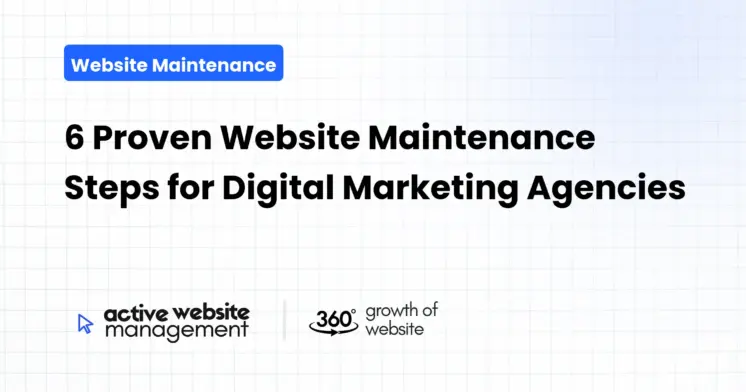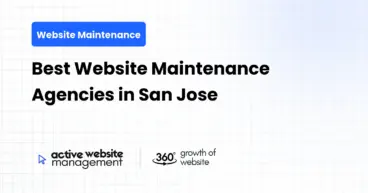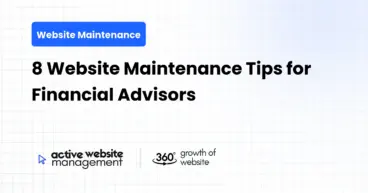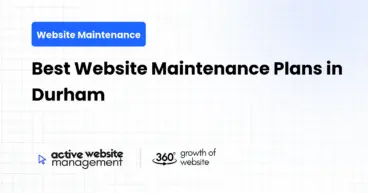January 20, 2025
17 min read
For digital marketing agencies, your website isn’t just a digital brochure – it’s the cornerstone of your brand, a lead generation magnet, and a testament to your expertise. A neglected website can erode client trust and actively hinder your growth. Conversely, a well-maintained, high-performing site showcases your skills and attracts ideal clients. This article delves into six essential website maintenance steps specifically tailored for digital marketing agencies, covering everything from the “what” and “why” to the “how,” ensuring your online presence is always at its peak.
1. Regular Security Audits: Protecting Your Digital Fortress
The What & Why of Security Audits
In the digital landscape, security is non-negotiable. For digital marketing agencies handling sensitive client data and running sophisticated campaigns, a security breach isn’t just an inconvenience – it’s a potential disaster. Security audits are systematic assessments designed to identify vulnerabilities in your website’s infrastructure. Think of it like a regular checkup for your car – you do it to catch problems before they become major breakdowns.
Why are these audits crucial?
- Data Protection: Protect your clients’ and your own sensitive information from hackers and data breaches. A leak can lead to reputational damage and financial loss.
- Website Uptime: Security breaches can lead to downtime, taking your website offline and hindering lead generation. This also damages your SEO and search ranking.
- Reputation Management: A secure website builds trust with prospective and existing clients. Clients need to be confident that their data is safe with a professional marketing agency.
- SEO Benefits: Google penalizes websites with known vulnerabilities. Security is a ranking factor, and neglecting it can hurt your visibility.
- Legal Compliance: Depending on your location and the type of data you handle, there may be legal requirements related to data security.
How to Conduct Effective Security Audits
- Vulnerability Scanning: Use tools like Sucuri SiteCheck, Qualys Web Application Scanning, or Acunetix to scan your website for known vulnerabilities. These automated tools identify common security issues like SQL injection, cross-site scripting (XSS), and outdated software.
- Software and Plugin Updates: Outdated CMS platforms, plugins, and themes are primary targets for hackers. Establish a regular update schedule and keep everything current. This is critical for WordPress-based sites, which are common in the agency space.
- Password Management: Enforce strong password policies and consider using a password manager for your team. Ensure that users are aware of the potential danger of reusing passwords across different services. Consider 2-factor authentication as well.
- Access Control: Limit access to your website’s back end and only grant necessary permissions to team members. Restrict access based on a user’s role and responsibility.
- SSL Certificate Verification: Ensure your website has a valid SSL certificate. This encrypts the communication between your website and users, protecting sensitive data. Look for the padlock icon in the browser address bar.
- Regular Backups: Implement a system for regular, automated website backups. Store backups in a separate location to ensure you can quickly restore your website in case of a breach or data loss.
- Web Application Firewall (WAF): A WAF acts as a shield between your website and the internet. It filters malicious traffic and protects against web attacks. Consider services like Cloudflare or Sucuri.
- User Activity Monitoring: Implement monitoring tools to track user activity and identify suspicious behavior. This can help you detect and address potential security threats early.
- Penetration Testing: For a more in-depth approach, hire a cybersecurity expert to conduct penetration testing. This involves simulating attacks to uncover vulnerabilities that automated tools may miss.
Don’t Just Maintain Your Website—
Grow It using Active Website Management! Don't Wait for Growth—Accelerate It with Active Website Management
When to Conduct Security Audits
- Weekly: Quick vulnerability scans and checking for software updates.
- Monthly: Review user access and website logs, perform a backup and test.
- Quarterly: In-depth review of security protocols and conduct penetration testing.
By regularly performing security audits, you can safeguard your agency website and client data, ensuring your digital presence remains a powerful asset. For SEO firms website upkeep, securing the website is vital to ensure their own efforts in SEO are not wasted by any hack or malware. Likewise, a secure site is critical for PPC agency maintenance, as any down time would impact paid campaigns and reduce ROI.
The What & Why of Performance Optimization
A slow-loading website is a major turn-off. In today’s fast-paced digital world, users expect instant results. Performance optimization focuses on improving your website’s speed and responsiveness, creating a positive user experience. This has a direct impact on bounce rates, conversion rates, and overall SEO.
Why is Performance Optimization Essential?
- Improved User Experience: Users are more likely to stay on a fast-loading website and engage with your content. This reduces bounce rates and increases time on site.
- Higher Conversion Rates: A quick website reduces friction and encourages users to complete desired actions (e.g., filling out a contact form, downloading a resource).
- SEO Ranking Factor: Google uses page speed as a ranking signal. A fast website has a higher chance of ranking higher in search results.
- Mobile-First Indexing: Google prioritizes mobile-friendly websites, and page speed is critical for a positive mobile experience.
- Increased Engagement: Visitors are more likely to explore your website and consume more content on a fast-loading site.
How to Optimize Website Performance
- Image Optimization: Compress images to reduce file sizes without compromising quality. Use tools like TinyPNG, ImageOptim, or ShortPixel. Choose appropriate file formats like JPEG for photos and PNG for graphics.
- Minify CSS, JavaScript, and HTML: Remove unnecessary characters (e.g., spaces, comments) from code files to reduce their size. Tools like CSSNano and UglifyJS can help.
- Leverage Browser Caching: Implement browser caching to store static files (images, CSS, JavaScript) locally on users’ devices. This reduces server requests and load times.
- Content Delivery Network (CDN): A CDN stores copies of your website on multiple servers located around the world. This ensures faster loading times for users, regardless of their location. Cloudflare and Amazon CloudFront are good options.
- Optimize Database: Clean up your database by removing unnecessary tables, posts, and revisions. Consider plugins like WP-Optimize or WP-Sweep.
- Choose the Right Hosting Provider: Select a reliable hosting provider that provides sufficient resources (e.g., server speed, bandwidth) to handle your website’s traffic.
- Gzip Compression: Enable Gzip compression to compress files before they are transmitted over the network. This reduces the data that needs to be downloaded by users’ browsers.
- Lazy Loading: Implement lazy loading for images and videos so they are only loaded when they come into view. This significantly improves initial page load times.
- Reduce HTTP Requests: Minimize the number of HTTP requests by combining CSS and JavaScript files, using CSS sprites, and optimizing the use of external resources.
- Use a Caching Plugin: Install a caching plugin like WP Rocket, W3 Total Cache, or LiteSpeed Cache to store static versions of your website.
When to Optimize Website Performance
- Continuously: Website performance is an ongoing process. Monitor your site’s speed regularly and implement necessary adjustments.
- After Major Changes: When you make significant changes to your website (e.g., design changes, new functionality), re-optimize to ensure performance remains optimal.
- After Traffic Surges: Spikes in traffic can impact performance. Re-evaluate and optimize to handle the extra load.
Marketing agency site care demands a focus on a website’s loading speed and overall responsiveness. For a digital agency, a sluggish site sends the wrong message to potential clients. Optimizing speed is not just about user satisfaction, but also about showcasing expertise in delivering fast, high-quality digital experiences.
3. Content Updates and Refreshments: Staying Relevant and Engaging
The What & Why of Content Updates
In the ever-evolving digital landscape, content is king. However, even the best content can become outdated over time. Content updates and refreshments involve regularly reviewing and updating your website content to ensure it remains accurate, relevant, and engaging for your target audience.
Why is Fresh Content Crucial?
- SEO Benefits: Google prioritizes fresh and relevant content. Regularly updated content is a ranking factor and helps your website rank higher in search results.
- User Engagement: Engaging and up-to-date content keeps users interested and encourages them to spend more time on your site.
- Authority and Trust: Regularly updating your content demonstrates your expertise and builds trust with your audience.
- Lead Generation: Fresh and relevant content attracts leads and helps drive conversions.
- Brand Image: Up-to-date content enhances your brand’s image and reinforces your position as a leading digital marketing agency.
- Competitive Advantage: High quality content that reflects the latest trends helps you stand out from your competitors.
How to Refresh and Update Content
- Content Audit: Conduct a thorough audit of your website content to identify outdated, irrelevant, or low-performing pieces. This includes blog posts, service pages, case studies, and other written material.
- Keyword Research: Use keyword research tools to identify relevant keywords and phrases that your target audience is searching for. Incorporate these keywords into your content for improved SEO.
- Update Statistics and Data: Ensure all statistics, data, and facts are up to date and accurate.
- Add New Information and Insights: Add new information, insights, and perspectives to your content to keep it fresh and engaging. This is critical in an industry that evolves as fast as digital marketing.
- Optimize Visuals: Update visuals (e.g., images, videos, graphics) to make your content more appealing and engaging.
- Check for Broken Links: Repair any broken links to ensure users can easily navigate your website.
- Re-optimize for SEO: Re-optimize content for search engines by updating title tags, meta descriptions, header tags, and internal linking.
- Repurpose Content: Repurpose your existing content into different formats such as videos, infographics, and podcasts.
- Blog Regularly: Consistently publish fresh blog posts on topics that are relevant to your target audience and industry trends.
- Update Case Studies: Highlight your latest client successes with fresh case studies. Show tangible results.
When to Update and Refresh Content
- Regularly (Quarterly at a minimum): Schedule a regular review of your website content to ensure it remains accurate and relevant.
- After Major Industry Changes: Update content that’s affected by significant changes or trends in the digital marketing landscape.
- After a Significant Update: Major design or strategy updates may necessitate a content overhaul.
- When Content is Underperforming: If you notice a content piece is not performing well (low traffic or engagement), review and update it.
SEO firm website upkeep is incomplete without constant content refreshment. Search algorithms favour up-to-date, accurate information. Similarly, for PPC agency maintenance, having engaging and relevant landing pages is critical for campaign success. Fresh content keeps your site relevant and helps convert more visitors into customers.
Don't Wait for Growth—Accelerate It with
Active Website Management Don't Wait for Growth—Accelerate It with Active Website Management
4. SEO Monitoring and Optimization: Driving Organic Traffic
The What & Why of SEO Monitoring
For a digital marketing agency, SEO isn’t just a service you provide – it’s the lifeblood of your own online visibility. SEO monitoring and optimization involves continuously tracking your website’s SEO performance and making necessary adjustments to improve your search engine rankings.
Why is Consistent SEO Monitoring Essential?
- Improved Search Rankings: Continuous SEO efforts ensure your website ranks high in search results, increasing organic traffic and visibility.
- Increased Organic Traffic: Higher search rankings translate to more visitors to your website who are actively looking for your services.
- Lead Generation: Organic traffic often leads to high-quality leads who are more likely to convert.
- Competitive Advantage: Effective SEO helps you outrank your competitors and attract more customers.
- Data-Driven Decisions: Tracking SEO data allows you to make informed decisions and adjust your strategies for maximum effectiveness.
- Brand Awareness: Increased organic visibility leads to higher brand awareness and recognition.
How to Monitor and Optimize Your SEO
- Keyword Tracking: Monitor your website’s ranking for target keywords using tools like SEMrush, Ahrefs, or Moz Pro. Track keyword rankings over time to identify trends and changes.
- Organic Traffic Analysis: Track organic traffic to your website using Google Analytics. Analyze trends in traffic volume and sources, and identify pages that are performing well and those that need improvement.
- Backlink Monitoring: Monitor your backlink profile for quality and quantity using tools like Ahrefs or Majestic. Disavow toxic backlinks to prevent penalizations.
- Technical SEO Audits: Conduct regular technical SEO audits to identify issues that may be hindering your rankings. This includes site speed, mobile-friendliness, and indexing.
- On-Page Optimization: Optimize your website content for target keywords by improving title tags, meta descriptions, header tags, image alt text, and content.
- Off-Page Optimization: Build high-quality backlinks from reputable websites to increase your website’s authority and rankings.
- Content Optimization: Ensure your content is high-quality, relevant, and engaging to attract and retain visitors.
- Mobile-Friendliness: Ensure your website is mobile-friendly and provides a positive experience on all devices.
- Schema Markup: Use schema markup to help search engines understand your content and display rich snippets in search results.
- Analyze Competitors: Research your competitors’ SEO strategies and identify opportunities to improve your own.
- Update Your Sitemap: Ensure your XML sitemap is up to date and accurately reflects all the pages on your website. Submit your sitemap to Google Search Console.
- Monitor Core Web Vitals: Pay attention to the Core Web Vitals (LCP, FID, CLS) as they are key to Google’s ranking algorithm.
When to Monitor and Optimize SEO
- Continuously: SEO is an ongoing process. Monitor your SEO performance regularly and make adjustments as needed.
- Monthly: Conduct a detailed SEO analysis, review keyword rankings, and monitor your organic traffic.
- Quarterly: Conduct technical SEO audits and review your backlink profile.
- After Algorithm Updates: Adjust your strategy based on significant algorithm updates from Google or other search engines.
Marketing agency site care should prioritize consistent SEO monitoring and optimization. Your agency’s website should be a case study in effective SEO practices. Similarly, for both SEO firm website upkeep and PPC agency maintenance, a high-ranking website generates qualified leads and increases brand credibility, showcasing your skills to potential clients.
5. Functionality Testing: Ensuring Smooth Operations
The What & Why of Functionality Testing
A website that doesn’t function properly frustrates users and damages your reputation. Functionality testing involves thoroughly assessing all interactive elements of your website to ensure they work as intended. This includes forms, buttons, links, and any other interactive components.
Why is Functionality Testing Essential?
- Improved User Experience: A well-functioning website provides a smooth and seamless user experience, increasing engagement and satisfaction.
- Higher Conversion Rates: Broken forms or links can prevent users from completing desired actions, impacting conversion rates.
- Professionalism and Trust: A website that works flawlessly builds trust and confidence with your audience.
- Reduced Bounce Rates: When a website functions poorly, people are likely to leave, increasing bounce rate. Functioning sites will keep them engaged.
- Positive Brand Image: A properly functioning website reflects your agency’s professionalism and competence.
- Lead Generation: Testing helps ensure that your lead capture mechanisms (forms, calls to action) work effectively.
How to Conduct Functionality Testing
- Form Testing: Test all forms on your website to ensure they submit data correctly and that error messages are clear.
- Link Testing: Check all links on your website to ensure they are functioning and lead to the correct pages. Use tools like Broken Link Checker for automated testing.
- Button Testing: Ensure all buttons on your website are working as intended and that they trigger the correct actions.
- Interactive Element Testing: Test all interactive elements on your website, such as sliders, tabs, and drop-down menus.
- Cross-Browser Testing: Ensure your website functions correctly across different browsers (e.g., Chrome, Firefox, Safari, Edge) and different versions of these browsers.
- Device Testing: Ensure your website functions correctly on various devices (e.g., desktops, laptops, tablets, smartphones) and various screen sizes.
- User Experience Testing: Have team members or trusted users test your website and provide feedback on their experience. Use usability tools like Hotjar to gain insights.
- Checkout Process Testing: If you have an online checkout system, test this thoroughly.
- Loading Time Testing: Check loading times on various elements. This should be performed as a general check and in depth when functionality problems appear.
When to Conduct Functionality Testing
- Regularly (Weekly): Perform quick checks of critical functionality such as forms and key links.
- After Website Changes: Whenever you make changes to your website, such as updates or redesigns, test all related functionality to ensure everything is still working.
- Before and After Major Campaigns: Test key lead generation aspects of your site to make sure that there are no problems before a campaign, and review again after for traffic spikes.
- After Updates: Always test after any software or plugin updates that are performed.
SEO firms website upkeep must prioritize functionality as a key part of their website management. No amount of SEO will help if a contact form is broken. Similarly, smooth functioning landing pages are crucial for PPC agency maintenance, ensuring that paid traffic is converted into leads.
6. Website Backup and Recovery: Disaster Preparedness
The What & Why of Backups and Recovery
Even with the best maintenance practices, unexpected issues can occur. Website backups and recovery involve regularly creating backups of your website and ensuring you have a plan to restore it quickly in case of data loss or a website failure.
Why is Website Backup and Recovery Essential?
- Data Protection: Backups protect your website data from loss due to security breaches, server failures, or human error.
- Quick Recovery: A proper backup and recovery plan ensures you can restore your website quickly and minimize downtime.
- Business Continuity: Having backups allows you to quickly resume business operations after a disruptive event.
- Peace of Mind: Backups provide peace of mind knowing that your data is safe and can be restored.
- Reputation Management: Quick recovery minimizes downtime, preserving your brand’s reputation.
- Reduced Financial Loss: Downtime can result in loss of revenue. Backups help you get back online quickly and reduce potential losses.
How to Implement Website Backup and Recovery
- Automated Backups: Use automated backup solutions such as UpdraftPlus, BackupBuddy, or VaultPress to ensure that backups are performed regularly without manual intervention.
- Full Website Backups: Back up all aspects of your website, including the database, website files, and images.
- Cloud Backups: Store backups in a secure cloud storage location such as Dropbox, Google Drive, or Amazon S3.
- Offsite Backups: Store backups on a separate server or offsite location to ensure they are safe from local disasters.
- Backup Testing: Regularly test your backup and recovery process to ensure it functions correctly.
- Multiple Backup Versions: Store multiple versions of your website backups so you can recover from different points in time.
- Data Retention Policies: Define how long your backups will be retained so you can manage backup storage effectively.
- Documented Recovery Process: Create a documented recovery process that clearly outlines the steps to restore your website from a backup.
- Regular Backup Validation: Routinely validate your backups to confirm data integrity.
When to Backup Your Website
- Daily Backups: For mission-critical websites, perform daily backups to ensure you can recover from the most recent version.
- Weekly Backups: For less critical websites, perform weekly backups.
- Before Major Updates: Always back up your website before making any major changes, such as theme updates or plugin installations.
- Before Testing: Back up the site before any heavy testing.
Active Website Management can be a valuable partner in simplifying these critical maintenance tasks, providing automated backup solutions, performance optimization tools, and security monitoring.
For marketing agency site care, a robust backup and recovery plan is a non-negotiable requirement. The ability to quickly restore a site after an incident is paramount. This is especially true for SEO firm website upkeep and PPC agency maintenance, where any downtime can have immediate negative effects. With proper backup and recovery practices, your digital agency can ensure maximum website resilience and maintain operational continuity.







